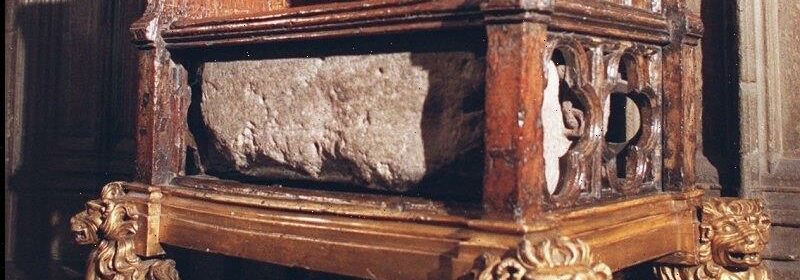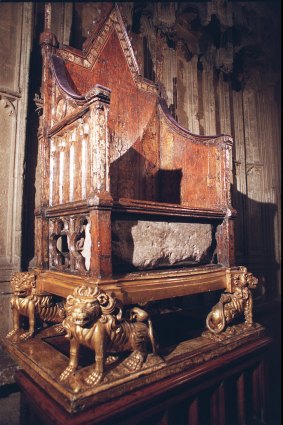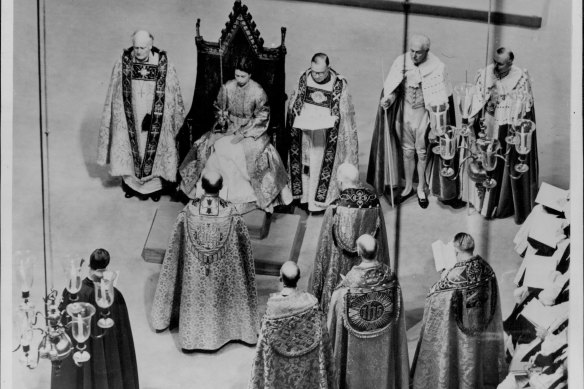King Charles’s restless Stone of Destiny waits atop the Royal Mile

London: As King Charles III arrives in Edinburgh, Scotland, to receive the condolences of the Scottish Parliament and to stand vigil over his mother’s coffin, an ancient symbol of power sits and waits for him high above in Edinburgh Castle.
The ancient Stone of Scone beneath the Coronation Chair in London’s Westminster Abbey.Credit:AP
It is a simple block of red sandstone.
But it has a restless history stretching back 1200 years.
It speaks silently of the fragile nature of the relationship between the two largest countries of the United Kingdom – Scotland and England – and of the mysterious rituals embedded within the British monarchy.
The stone will have a central role in the ceremony months ahead when Charles is formally crowned King of the United Kingdom and 14 other Commonwealth realms, including Australia.
The battered block is known variously as the Stone of Scone and the Stone of Destiny in Scotland, the Coronation Stone in England, and among some, as Jacob’s Pillow.
Queen Elizabeth II was crowned upon the stone during the Coronation ceremony in Westminster AbbeyCredit:Planet News
It sat in what is now the ruined Scone Abbey near Perth, central Scotland, from 841 AD, and served for centuries in the coronation rituals of Scottish Kings.
But in 1296, during the first Scottish War of Independence, the forces of King Edward 1 of England – a monarch known as “the Hammer of the Scots” – seized the stone and took it south to Westminster Abbey, London.
A wooden chair was fitted to it, and almost all English – and then British – sovereigns have since been crowned upon it.
The last was Charles’s mother, Elizabeth II, on June 2, 1953. And now it is Charles’s turn.
The removal as a spoil of war from Scotland to England 726 years ago was not to be the last of the stone’s forced travels, however.
Its symbolic value was invested with such importance that during World War II, it was removed from Westminster Cathedral and hidden in Gloucester Cathedral for fear it otherwise might be damaged or destroyed by German bombs.
Only a tiny number of people were made aware of the stone’s whereabouts.
Lest it be lost forever, two maps of its hiding place were sent to Canada. The Canadian Prime Minister lodged one map in a Bank of Canada vault and the Lieutenant Governor of Ontario locked his in the vault of the Bank of Montreal in Toronto.
After the war, with the stone back in Westminster Abbey, four Scottish nationalist students crept in on Christmas night, 1950, and removed the block, which weighs about 152kg.
Handily, it has two metal rings set into its ends for carrying purposes.
The stone broke into two, and the students buried it in a field in Kent. The larger part was spirited to Scotland within a few days, with the smaller broken part following.
A Glasgow politician arranged secretly for a stonemason to seamlessly rejoin the broken ends.
Eventually, the stone was left on the altar of the Arbroath Abbey, between Dundee and Aberdeen. This was highly symbolic: in 1320 a letter known as the Declaration of Arbroath was written by Scottish barons, asserting the independence of the Kingdom of Scotland and denouncing English attempts to subjugate it.
English police, who had been searching frantically for the stone, were informed of its whereabouts four months after it went missing.
It was returned to Westminster Cathedral, where two years later, Elizabeth II was crowned in the wooden chair fitted to the stone 657 years previously.
But Scottish nationalists remained indignant that the Stone of Scone was in the hands of the English.
In 1996, with calls for Scotland to break away from the British union unsettling the Conservative Party of Prime Minister John Major, the British Government made a significant gesture of peace.
The stone was returned to Scotland, precisely 700 years after Edward I had stolen it.
It has sat ever since in Edinburgh Castle with the Scottish Crown Jewels.
However, with the coronation of a new King likely to occur in the British spring or summer of next year, the stone faces another journey.
It will be taken south to Westminister Abbey, Edward’s ancient chair will be affixed to it and Charles, seated atop, will be crowned, like his mother, with St Edward’s Crown, made of solid gold and studded with 400 precious gemstones including sapphires, garnets and rubies.
And then the ancient Stone of Scone, Stone of Destiny, Coronation Stone and Jacob’s Pillow, will be returned carefully to Edinburgh Castle.
There it will sit, up The Royal Mile above King Charles’s official Scottish seat, the Palace of Holyrood House, where this week, his mother’s body will lie in its coffin, paused on its journey from Balmoral Castle to London, Charles standing vigil.
But its journeying might not yet be done.
Two years ago, Scottish First Minister Nicola Sturgeon announced a plan to return the stone by 2024 to Perth, which was described as its “spiritual home”.
The Morning Edition newsletter is our guide to the day’s most important and interesting stories, analysis and insights. Sign up here.
Most Viewed in World
From our partners
Source: Read Full Article

